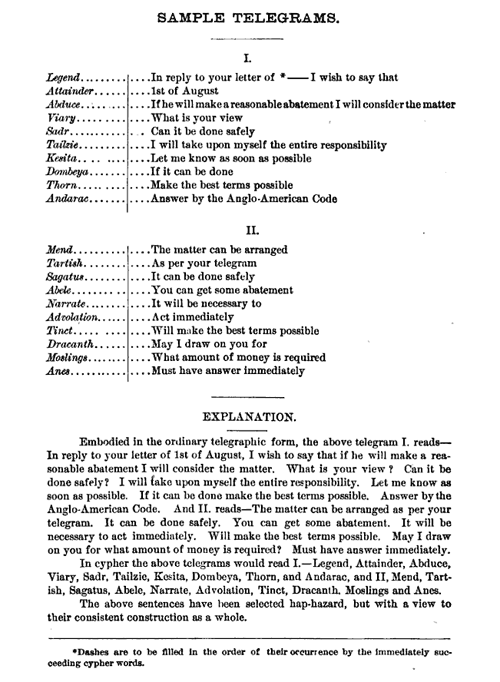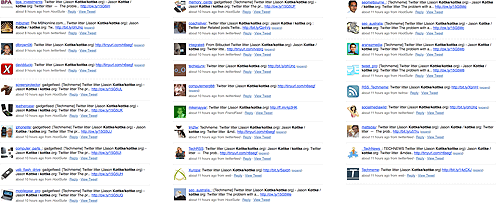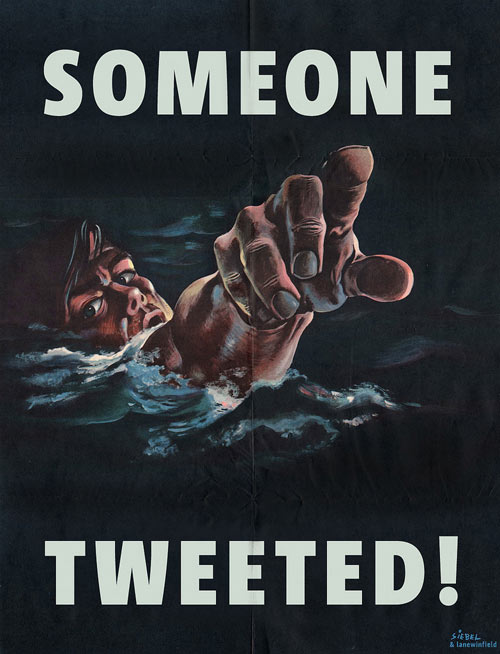kottke.org posts about Twitter
If you can figure out what words are gonna trend on Twitter, you can use the pretweeting site to buy and sell words to make fake money.
Make a (virtual) profit by buying and selling words on twitter. Predict what’s going to be hot and buy it up before it hits twitter, and you’ll make a killing once people start talking about it.
This is like Google Adwords except with play money. (via waxy)
Regarding the previous post on Twitter and the telegraph, eagle-eyed kottke.org reader Mark spotted this gem on page 401 of the telegraphic code book:

I heard that “tunnel is in ore” was @jack’s first name for the service; that it was shortened to Twitter makes a lot of sense now. (thx, mark)
Ben Schott on the similarities between the telegraph and Twitter:
The 140-character limit of Twitter posts was guided by the 160-character limit established by the developers of SMS. However, there is nothing new about new technology imposing restrictions on articulation. During the late 19th-century telegraphy boom, some carriers charged extra for words longer than 15 characters and for messages longer than 10 words. Thus, the cheapest telegram was often limited to 150 characters.
Schott also shares about 100 words from The Anglo-American Telegraphic Code, a code book that reduced long phrases into single words in order to cut down on telegraphic transmission costs. The full book is available for reading on Google and it includes over 27,000 code words on 460 pages!

Get traffic and transit updates for NY on Twitter…including NYC subway lines! There are separate accounts for the 123, ACE, JMZ, 456, BDFV, LS, 7, G, and NQRW. (via @bobulate)
Update: @NYCtrains also does NYC subway updates. (thx, pierre)
Steven Garrity lists a short selection of metaphors related to technology freedoms. Like:
If Twitter were a phone company, you could only call people who used the same phone company as you.
Got any good ones to add to the list?
Dave Winer has been irritated for some time at Twitter’s suggested users list. I don’t like the list either…it steers Twitter in a direction I don’t care for. Winer suggests several ways in which Twitter can address the problems with the list but there’s a really good simple solution:
Make the list entirely random consisting of selections from the entire Twitter userbase. After signing up, each new user sees 100 recommended accounts randomly chosen out of a HUGE pool of non-spam accounts (where HUGE = hundreds of thousands) that have been active for more than 3 months, tweet more than 5 times a week & fewer than 10 times a day, and have 2 times as many followers as followees (or something like that). Twitter has to be doing similar calculations to find spam accounts…just reverse it and whitelist accounts for the recommended list. That way, Twitter gets what they want (new users following people) and the super-user & conflict of interest problems are eliminated.
I guess I should have included “if the link is posted to TechMeme” in the Twitter litter list.

A more readable list is here.
The problem with all of the “we’re tracking the most popular links on Twitter” sites is that link sharing on Twitter depends on (in order of decreasing relevance):
1. the time it takes to read/view the link (shorter is way better)
2. if the subject of the link is Twitter or Facebook
3. the sense of outrage aroused in the reader (the more the better)
4. if the link was published by fucking Mashable
5. retweets by popular Twitter users who have many parrot followers (i.e. disciples)
6. how interesting the link is
So unless you’re into brief but outrageous Twitter news from Mashable that you heard about from Robert Scoble — and it is incredible the number of people who are — these services just aren’t that useful. (As this post itself meets several of the above criteria, feel free to retweet.)
The scamps at Nature are updating the ApolloPlus40 Twitter account as the Apollo 11 mission happened 40 years ago. (thx, matt)
Yesterday I linked to a long piece by attorney Brock Shinen discussing whether individual posts to Twitter are copyrightable and asked:
Does this mean that nearly all of Twitter’s content is in the public domain? Or can you copyright a collection of tweets…the entire output of one person, for instance?
Brock sent along a short reply to my question, reprinted here with his kind permission:
This is information and not advice: It’s possible (and likely) that the majority of individual Tweets are in the public domain. But copyright protection may extend to a compilation of otherwise non-protectable Tweets. The question of whether ‘you’ can do that as opposed to the author of those Tweets is tricky and would depend on how it’s done. If the compilation is authored in such a way as to suggest a false designation of origin (i.e., that the person compiling the Tweets actually authored them), you might run into false designation claims. Also, as a practical matter, you may still get sued and forced to spend tens of thousands of dollars to defend a lawsuit you might otherwise win - if you can afford to get to trial. In the end, if you are a Tweet author and want to protect your Tweets, then you should probably compile them and seek protection with the US Copyright Office. If that works out for you, you’re set. If the Copyright Office denies your application for registration, you have your answer.
In the opinion of intellectual copyright attorney Brock Shinen, the short answer is “no”.
I admit, I think a protectable Tweet exists in theory. I have read hundreds if not thousands of Tweets and have yet to read one I believe would be protectable, but the possibility exists. The question is not: Are Tweets Copyrightable. The question is: Is This Tweet Copyrightable. The copyrightability of Tweets is not dependent on the fact that they are Tweets. Rather, it’s dependent on the analysis of the Tweet in question. The all-encompassing response that all Tweets are either protected or not protected is misguided. The real response is that it depends. However, when you analyze most Tweets, they would never individually pass copyright muster.
Does this mean that nearly all of Twitter’s content is in the public domain? Or can you copyright a collection of tweets…the entire output of one person, for instance? Let’s say I want to publish Tweatise: The Wit and Wisdom of Merlin Mann, an unabridged book of Merlin’s Twitter stream…can I do that?
Update: Another opinion: tweetCC.
tweetCC makes it easy for you to offer your tweets under a Creative Commons Public Domain Dedication or other Creative Commons licenses.
(thx, dan)
Update: Yet another perspective.
By Meg Pickard, a graph of the lifespan of Twitter trending topics compares “people talking about #topic” and “people talking about talking about #topic”. Outside of Twitter, this applies to pretty much any popular newsworthy topic…the news quickly moves from “we’re telling you about Topic X” to media coverage of the media coverage of Topic X. See: Twitter’s own coverage in the media currently. (thx, @ davidfg )
This “small settings update” to Twitter sucks.
We’ve updated the Notices section of Settings to better reflect how folks are using Twitter regarding replies. Based on usage patterns and feedback, we’ve learned most people want to see when someone they follow replies to another person they follow — it’s a good way to stay in the loop. However, receiving one-sided fragments via replies sent to folks you don’t follow in your timeline is undesirable. Today’s update removes this undesirable and confusing option.
The semi-private/semi-public thing that Twitter has going on is one of the most significant features of the service, IMO. It’s the magic. There’s serendipitous social discovery factor but more to the point: when I follow someone, I want to see *everything* they post. Those @replies to my friends’ friends are part of their narrative, part of what I want to hear from them. Arbitrarily cutting out some tweets sucks. Besides, isn’t the “problem” solved by this “feature” mostly addressed by locked accounts and private messaging?
It’s also odd that Twitter would release this feature, which makes it easier for people to communicate in self-contained groups, when it seems like the company is moving in the opposite direction towards a broadcast model, where the emphasis is on tweeting at large groups of people that you don’t know. Two big examples:
1. They inserted a “suggested users” step in the sign-up process which made a small number of people on Twitter into superusers and implied to new users that Twitter is a service for following celebrities instead of chatting with your friends.
2. And then there’s all the press they’ve been doing. You don’t go on Oprah to talk about how Twitter is for small groups.
(Would you like to post this link to Twitter?)
Update: Twitter reversed their decision on this. Sort of.
First, we’re making a change such that any updates beginning with @username (that are not explicitly created by clicking on the reply icon) will be seen by everyone following that account.
This sentence is also interesting:
The problem with the setting was that it didn’t scale and even if we rebuilt it, the feature was blunt. It was confusing and caused a sense of inconsistency.
I’m not sure that makes any sense to anyone who doesn’t work at Twitter. Maybe Twitter will wow us with simple and intuitive per-user controls but it seems to me that the service works best when it’s simple. Having to think about to what degree you’re following someone multiplied the number of people you’re following starts to feel like the friendship maintenance crap that everyone loves to hate about other social networking sites.
Living in a big city, you get to hear other people’s conversations all the time. These are private conversations meant for the benefit of the participants but it’s no big deal if they’re overheard on the subway. And you know what people talk about most of the time? In no particular order:
1. What they had or are going to have for breakfast/lunch/dinner.
2. Last night’s TV or sports.
3. How things are going at work.
4. The weather.
5. Personal gossip.
6. Celebrity gossip.
Of course you’d like to think that most of your daily conversation is weighty and witty but instead everyone chats about pedestrian nonsense with their pals. In fact, that ephemeral chit-chat is the stuff that holds human social groups together.
Ever since the web hit the mainstream sometime in the 90s, people have asked of each new conversational publishing technology — newsgroups, message boards, online journals, weblogs, social networking sites, and now Twitter — the same question: “but why would anyone want to hear about what some random person is eating for breakfast?” The answer applies equally well for both offline conversation and online “social media”: almost no one…except for their family and friends.
So when you run across a Twitter message like “we had chicken sandwitches & pepsi for breakfast” from someone who has around 30 followers, what’s really so odd about it? It’s just someone telling a few friends on Twitter what she might normally tell them on the phone, via email, in person, or in a telegram. If you aren’t one of the 30 followers, you never see the message…and if you do, you’re like the guy standing next to a conversing couple on the subway platform.
P.S. And anyway, the whole breakfast question is a huge straw man periodically pushed across the tracks in front of speeding internet technology. There is much that happens on Twitter or on blogs or on Facebook that has nothing to do with small groups of people communicating about seemingly nothing. Can we just retire this stupid line of questioning once and for all?
(Would you like to post this link to Twitter?)
Update: From Twitter, two pithier reformulations of the above:
@phoutz: If Twitter is banal it is because you and I are banal (It’s called social norming)
@thepalephantom: The “no one cares what you’re doing” proclamation is a solipsists way of saying “i don’t care”
Update: Three related articles. How the Other Half Writes: In Defense of Twitter by Geoff Manaugh of BLDGBLOG (thx, @secretsquirrel):
Again, I fail to see any clear distinction between someone’s boring Twitter feed - considered only semi-literate and very much bad — and someone else’s equally boring, paper-based diary — considered both pro-humanist and unquestionably good. Kafka would have had a Twitter feed! And so would have Hemingway, and so would have Virgil, and so would have Sappho. It’s a tool for writing. Heraclitus would have had a f***ing Twitter feed.
Twitter: Industries of Banality by Struan McRae Spencer of Vitamin Briefcase:
Living with friends and colleagues would be a cheap alternative to living alone. People generally don’t do it because it’s not a good thing for humans to do. We are genetically predisposed to need time in solitude occasionally. So instead of living with your friends and colleagues, try living with their disembodied thoughts floating around on your computer and popping up on your desktop every fifteen, thirty, sixty, (manual refresh), minutes. Fellowship exists to provide us with relief from solitude and our individual pursuits. Living in a state of constant fellowship with hundreds, if not thousands of people who have known you (or not) across various stages of your life becomes an insurmountable problem the longer you try to do it.
To Tweet or Not To Tweet by Maureen Dowd of the NY Times, the essay that finally set me off in the first place:
Do you ever think “I don’t care that my friend is having a hamburger?”
Keith Starky’s blog examines tweets as “part of his ongoing research in humor propagation and fluid reputation dynamics”.
The central conceit of the “tweet” in this case is the idea that Ninjas, which are black-clad martial artists who employ tactics of stealth to both defeat their opponents and avoid waking people up at night when they go to the bathroom, could partake in some of the worldy pleasures of the non-Ninja world (e.g., crunchy snacks) if that non-Ninja world consisted entirely of people wearing noise-canceling headphones. Henceforth we refer to this world as Headphone-World.
Sorry for the two “explains Twitter” posts in a row. I’ll make the next two extra special (i.e. “explains Facebook”). (via jim ray)
McSweeney’s explains Twitter. Finally!
Twitter seems to be, first and foremost, an online haven where teenagers making drugs can telegraph secret code words to arrange gang fights and orgies. It also functions as a vehicle for teasing peers until they commit suicide.
The McSweeney’s Twitter account has never been updated but has 702 followers.
Update: McSweeney’s official Twitter account is being updated but only has 439 followers. (thx, alex)
After threatening as much for many months, Joshua Schachter has published a piece about how URL shorteners (TinyURL, bit.ly, is.gd, etc.) suck for everyone except the companies which build URL shorteners.
There are three other parties in the ecosystem of a link: the publisher (the site the link points to), the transit (places where that shortened link is used, such as Twitter or Typepad), and the clicker (the person who ultimately follows the shortened links). Each is harmed to some extent by URL shortening.
I agree with Schachter all around here. With respect to Twitter, I would like to see two things happen:
1) That they automatically unshorten all URLs except when the 140 character limit is necessary in SMS messages.
2) In cases where shortening is necessary, Twitter should automatically use a shortener of their own.
That way, users know what they’re getting and as long as Twitter is around, those links stay alive.
In response to a push for more tech literacy, British primary schools have proposed a new set of academic standards, including plans to study Twitter.
It seems to be going over fairly well with those at the head of the class. According to John Bangs, of the National Union of Teachers:
“Computer skills and keyboard skills seem to be as important as handwriting in this. Traditional books and written texts are downplayed in response to web-based learning.”
Let’s hope that history lectures don’t devolve into presentations on now-defunct MySpace pages and AOL screen-names.
via CNET
After Shaq tweets that he’s hanging out at a local diner in Phoenix, two nervous Twitter users venture out to see if Shaq is actually THE_REAL_SHAQ.
Returning to our hushed whispers I asked Sean, “Should we go talk to him now?” “I don’t know, should we?”
“Yes, you should” a very deep voice entered our conversation from 2 booths over.
(via truehoop)
Stephen Fry decided to start his own reality chat show yesterday after becoming stuck in an elevator. Here’s the show’s opening monologue, a photo of the cast, and thoughts from the audience. The ratings look pretty good so far.
The NY Times has a timeline map showing what people from around the country said on Twitter during the Super Bowl broadcast. I like the emoticons tab but they also should have included a profanity tab.
Sasha Frere-Jones lists a bunch of people who are on Twitter.
people who are just back from a really awesome run
people who are involved in “social networking” and optimizing the power of re-Tweeting and “computers”
people who can’t figure out what their kids want to eat
Shaquille O’Neal
people who have never seen snow
people who like Battlestar Galactica
Geordi La Forge, Data, and Wesley Crusher are all on Twitter. WHAT ARE YOU WAITING FOR, WORF?
And thus ends the first full week of Twittering by Shaquille O’Neal. The real Shaquille O’Neal. The NY Times has the details. Apparently Shaq was spurred into tweeting by an imposter posing as him:
“Somebody out there was trying to use my language and trying to speak for me,” O’Neal, sounding more amused than offended, said Wednesday night in a telephone interview. “Rather than have that happen, I thought I’d do it myself.” O’Neal added: “It’s a fun thing. It’s a way for fans to connect.”
Used to dashing off one-liners to reporters during pre- and post-game interviews, O’Neal is a natural at Twitter’s short format. He’s already cleared the murky air about his feelings regarding ex-coach Phil Jackson and ex-teammate Kobe Bryant directly to his fans:
This is straight from the shaqs mouth I love phil jackson Kobe bryant is the best palyer in the game And the shaq kobe, kobe shaq was the best one two
One of the biggest uses of Twitter is for namedropping; Shaq picked up on that right away:
I just texted gary payton, one of the greatest point guards ever
He’s also urging his teammates to hop on the bandwagon:
Sittin next to steve nash, tryna get hi to join twitter
When Shaq said “it’s a way for fans to connect”, he wasn’t just blowing smoke. After a friend of mine followed THE_REAL_SHAQ early on, Shaq followed him back. My friend then sent him a direct message about something Shaq had said in an interview once and an hour later, a reply from Shaq: “gimme a numba 2 call”. And then Shaq called him for a brief chat an hour or two later!
Best of all, he’s having fun with it. On Friday, Shaq posted this photo to TwitPic:

That says it all, no? Tweet on, Shaq…we’re following you.
Several folks on Twitter are talking about post-election sex and Obama babies (children conceived on election night…mark your calendars for late July 2009). The consensus seems to be that Barack got laid in a big way last night.
This page on kottke.org is the #1 result when you Google “obama wins”. Servers may get a little melty around here in the next couple of days. That’s ok…this is what Twitter’s servers are going to look like tomorrow night:

Imagine this video, but with the fail whale instead of a real whale and a nuclear device instead of dynamite.
Twitter is fast becoming the real-time zeitgeist of the web hive mind. (Sorry, I don’t know what that means either.) Anyway, I’ve been playing around with Twist, which tracks trends on Twitter and graphs the results. Two of the most interesting trends I’ve found are:
drunk, hangover - The drunk talk spikes on Friday and Saturday nights, followed by hangover talk on the following mornings. There’s a similar correlation on Facebook.
monday, tuesday, wednesday, thursday, friday, saturday, sunday - This one is really interesting. Friday, Saturday, Sunday, and Monday get many more mentions than the three other days of the week, which shows the importance of the weekend in contemporary society. Wednesday is the low point, which turns the graph into a representation of hump day, only inverted.
Any other interesting trends that you’ve noticed?
Update: My wife reminds me that Plodt is tracking explicit Twitter trends…you can create personal or collective graphs by assigning values to words like so: *mood 8* or *weather 5*. Here’s a good example of a collective poll about how the candidates did during the debate at Hofstra.
Fun evening activity: type whatever crazy shit is happening on TV into Twitter Search and watch the wittisicms and not-so-witticisms roll by. Example: in game one of the World Series tonight, someone stole a base and every single person in the United States won a free taco from Taco Bell. Instant tweetalanche.
I don’t know what the best part of Twinkle is: being up at 8am on Saturday & Sunday mornings and reading messages from drunken Manhattanites heading home for the evening at 5am or watching guys attempting to flirt with ladies in their area via 140 character messages. Very entertaining.
BTW, Twinkle is a Twitter app that lets your= read what’s being Twittered near you (more or less).
Newer posts
Older posts










Stay Connected